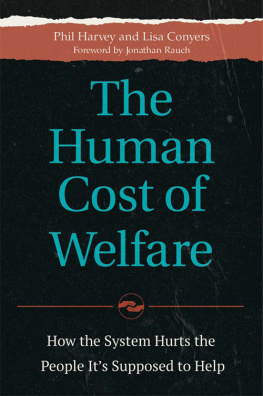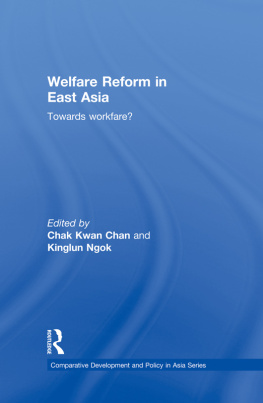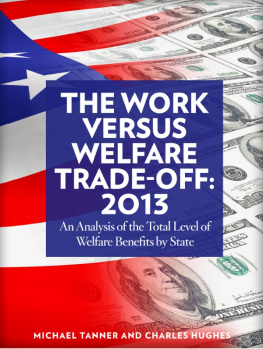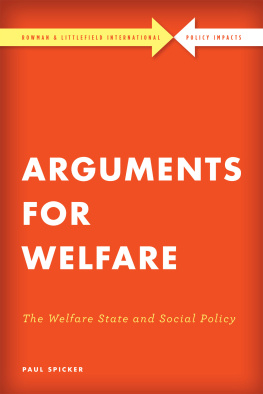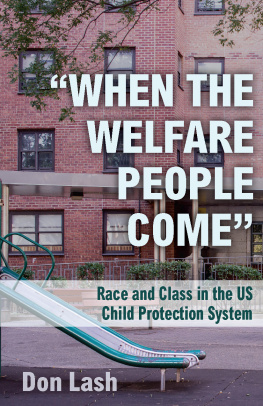

Copyright 2016 by Phil Harvey and Lisa Conyers
Foreword 2016 by Jonathan Rauch
All rights reserved. No part of this publication may be reproduced, stored in a retrieval system, or transmitted, in any form or by any means, electronic, mechanical, photocopying, recording, or otherwise, except for the inclusion of brief quotations in a review, without prior permission in writing from the publisher.
Library of Congress Cataloging-in-Publication Data
Names: Harvey, Philip D., 1938- author. | Conyers, Lisa, author.
Title: The human cost of welfare : how the system hurts the people its supposed to help / Phil Harvey and Lisa Conyers ; foreword by Jonathan Rauch
Description: Santa Barbara, California : Praeger, [2016] | Includes bibliographical references and index.
Identifiers: LCCN 2015039114 | ISBN 9781440845345 (alk. paper) | ISBN 9781440845352 (ebook)
Subjects: LCSH: Public welfareUnited States. | Welfare recipientsUnited States. | PoorUnited States. | United StatesSocial policy.
Classification: LCC HV95 .H327 2016 | DDC 362.5/8dc23 LC record available at http://lccn.loc.gov/2015039114
ISBN: 978-1-4408-4534-5
EISBN: 978-1-4408-4535-2
201918171612345
This book is also available on the World Wide Web as an eBook.
Visit www.abc-clio.com for details.
Praeger
An Imprint of ABC-CLIO, LLC
ABC-CLIO, LLC
130 Cremona Drive, P.O. Box 1911
Santa Barbara, California 93116-1911
This book is printed on acid-free paper 
Manufactured in the United States of America
For those who work, or will.
Contents
Figures, Tables, and Appendices
FIGURES
TABLES
APPENDICES
Foreword
Although transportation deregulation in the 1970s and Obamacare in 2010 have their supporters (and detractors), the 1996 recasting of welfare has a compelling claim to being the single most important federal reform of our time. By promising to end welfare as we knew it, Bill Clinton changed the Democratic Party, at least for a while; by forcing Clinton to accept changes that his party mostly loathed, Newt Gingrichs Republicans held him to his promise. By succeeding beyond almost everybodys hopes, the reform itself created a durable, bipartisan consensus around what had been a controversial idea: the best way to help people out of poverty is not to give them money but to help them work.
Today it is easy to forget the world before welfare reform, perhaps because that world is painful to remember. Aid to Families with Dependent Children (AFDC), the income-support program first designed during the New Deal for a very different country, was riddled with perverse incentives and outmoded provisions whose effect was to discourage work and family formation. By the Clinton era, even AFDCs supporters were exasperated with it, though they feared the consequences of replacing it. The 1996 reform required beneficiaries to work or seek job training, and it encouraged welfare agencies to move people off the dole and into jobs. The welfare rolls shrank, work effort increased, and the country learned some things. First, the emphasis on work was well founded: jobs confer not just income but also life skills, community standing, self-esteem, and a sense of vocation. Second, incentives matter. People really do respond to the rules. Third, the government can change incentives, and if it gets the changes right instead of wrong, a lot of people will be better off.
Those lessons are still important and relevant, which is why The Human Cost of Welfare is a book to read and ponder now. Although no one would exchange todays welfare programs for those of the 1980s, over the past couple of decades work requirements have eroded and new problems have arisen. If today there is a case of systemic failure equivalent to yesteryears broken AFDC, it would be the federal disability program, which analysts from across the political spectrum agree has not only grown beyond its intended mission but also actively discourages reintegration into the labor force. Participation in what used to be called food stamps (now called SNAP) has soared, partly because of the economy but also partly as a result of loosened eligibility and work requirements. By common consent, wage subsidies, another successful innovation of the Clinton era, need changing so that low-income workers without children can get them. And the cost of Medicaid, the health program for the needylike the cost of its big sister, Medicareis rising. Where will the money come from?
Meanwhile, looming in the background is todays most worrisome economic trend: working-class mens flight from work. Through the late 1960s, more than 95% of American men in their prime working years (that is, between 25 and 54) were in the workforce; beginning in the 1970s, male workforce participation declined steadily through times good and bad, falling to 88% by 2013 and showing no sign of bottoming out. Eighty-eight percent workforce participation may still seem pretty high, but there is more to the story. Men with four-year college degrees, about a third of the total, are still working at high rates. But the lower you go on the education ladder, the higher the labor force dropout rate becomes. According to the Hamilton Project at the Brookings Institution, fully a quarter of men with only high school degrees were out of the workforce in 2011, and a third of men without high school degrees had dropped out.
Why? No one is sure, but probably for several mutually reinforcing reasons. Well-paying jobs for less-skilled workers, the factory and farm jobs of days past, have grown more scarce. The low-skilled jobs that are around have moved away from traditionally masculine venues like construction sites and toward traditionally feminine ones like nursing homes, and so blue-collar men seem reluctant to take them. As women have streamed into the workforce and become breadwinners, it has become both more affordable and more socially acceptable for men to let women support them, and for women to dispense with men altogether. As more children are raised by single mothers, more grow up without strong male role models, which research suggests disadvantages boys more than girlsrepeating the cycle. And men, for reasons unknown, are not keeping up with women in the acquisition of education and skills.
All those and other variables figure in the equation, but here is the point: working-class men in the United States are in a tailspin. They are migrating out of the world of work and marriage, which for so many years defined masculine dignity, and they are enteringwell, some other world, one whose terrain is uncertain but probably not very attractive. What will these people do for money and dignity in an increasingly postindustrial, white-collar economy? How can public policy generally, and welfare policy specifically, help to reverse the cycle of nonwork, rather than exacerbating it? We dont have answers yet, but to find them we will need to ask the right questions, which Phil Harvey and Lisa Conyers do here.
Their book is valuable for many reasons. Although the authors have a point of view, they are careful with the evidence, offering an accurate and comprehensive account that leaves the reader to make the hard policy judgments. And the choices are hard, which the book acknowledgesanother virtue. Unlike many diatribes from both left and right, The Human Cost of Welfare
Next page
